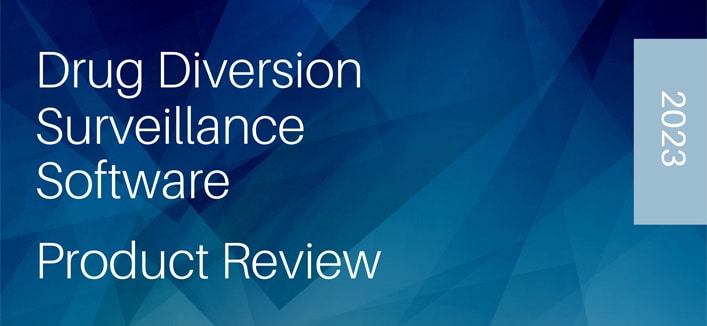Our Guests: Heidi Bragg, MBA, RPh, Drug Diversion Specialist, Darren Jones, Pharm D, BCPS, Pharmacy Director – Regulatory, Quality and Diversion, Alissa Voils, PharmD, MSHA, Director Medication Diversion Prevention
How much of a risk is residual waste? Is it a risk only in areas with high injectable medication usage? Join this pharmacist packed panel as we talk about our experiences and share some things to consider. Our goal is to give you something to think about and potentially open a dialog at your facility surrounding waste.
Transcript:
Terri
Welcome back, listeners. Our sponsor for today’s episode is MIDAS Healthcare Solutions. They are introducing a new product to help prevent medication diversion. MIDAS View provides for the first time anytime witness technology, allowing the convenience and flexibility when a witness is required in the disposal of unused controlled substances. Also, their 360 degree camera provides real time and on demand visual proof the medication was actually discarded. You can visit MIDAS at booth 431 at the Midyear ASHP meeting in December. Today, I have a great panel of pharmacists between them with their experience throughout the years, they represent so many aspects of pharmacy. But what they all have in common at this moment, in addition to the same background, is their career in overseeing the diversion mitigation program for their respective organizations. So first we have Heidi Bragg, the diversion specialist at Texas Children’s.
Terri
Also, she also teaches pharmacy law at the University of Texas at Tyler Fitch and the University of Houston College of Pharmacy. Next, Alissa Voils, the director of medication diversion prevention for Mayo Clinic. And third, our returning guest, Darren Jones, the pharmacy director overseeing regulatory quality and diversion for Karelian Clinic. I’m going to start with a definition of residual waste for the purposes of this discussion and then a little bit of background on what prompted this discussion. So welcome first, everybody. Welcome to the podcast. So, residual waste for today’s purposes, it’s those little bit of dribbles of medication left in the vial after the whole vial has been used, the stuff that you really can no longer reach in with a needle and syringe and remove. So you contrast that to overfill, which is a measurable volume that you can draw up, right.
Terri
And the larger the vial, the more the overfill that you have. They’re related, most certainly, and we’ll probably end up discussing both today. But we’re going to start with residual waste. And the idea for this podcast developed when I spoke with Darren over a meal at a conference recently, and he shared a little bit about what he was facing surrounding residual waste. And I think it’s something that maybe not many of us think about unless we have seen diversion utilizing residual waste. Right. So let’s start there. Darren, please share with the listeners what it is or was that you were going through at your facility that involved that.
Darren
Mean this all started years ago when you hear those stories about diversion happening out of red sharps containers. And a lot of that was probably overfill, like you mentioned. But we’ve really worked hard to ensure that there’s nothing in those vials when it goes into whatever waste stream you’re going into. And for us, there was some concern that if we’re just throwing empty vials that have residual waste in them into the regular trash flow, then the community has access to those once they go to the landfill or wherever. So in our minds, the appropriate thing to do was to put those empty vials in red sharps containers, and we have red sharps containers in all our ors, in the pharmacy, everywhere.
Darren
And so this all started when some of the or management noticed that one of the locking mechanisms, which was plastic one of those red bins, had been broken open. And they said, well, maybe somebody was it was on a cart. Maybe they were wheeling the cart around the corner and it bumped against the wall. So they kind of just wrote that off. And then two weeks later, they noticed a different cart with the same problem in a different area. And so the chances of that probably pretty slim. So we started treating it as a diversion type issue. And so we looked, are the anesthesiologists not wasting their overfill like they should be? That wasn’t the case.
Darren
So the only thing we could come up with was somebody’s accessing these red bins, whether it’s environmental services, pharmacy, or anesthesia or nursing, and they’re going for the residual waste in these vials, which, if you hold a vial up, you can see right around the ring there’s a little bit in there. Maybe it’s only ten microliters or something really small, but it’s harder to get out with a beveled needle because you got the bevel there holding it up. Right. Anyway, so we didn’t have any cameras in the or anything. We didn’t have a way to identify an individual. So we said, fine, we’ll beef up the security on these things so that it’s harder to access them. So we put metal locking brackets on it. Now, they’re not heavy duty brackets or anything. You could still probably take a screwdriver.
Darren
But the idea was if somebody’s accessing these, maybe you could at least hear them, right? And it happened again.
Terri
And you didn’t hear them, nobody heard them.
Darren
They had a good method anyway. So now we’re dealing with this thing. Well, are these empty residual waste vials being pooled somewhere? Granted, it’s probably going to take 50 of them to get any kind of measurable volume out of, but in high use areas like the or, there’s probably easily that many vials in a red bin at any given time. So now we’re in the process of collecting empty vials, and Pharmacy is managing this. And so went to this conference and I was like, is anybody else dealing with this? Because we talked about this. It’s one more thing, right, in the diversion process, and it seems like we shouldn’t have to deal with it.
Terri
Right? Yeah. Well, we’ve said how people that are desperate for the medication, they’re going to find ways around it, right. So it just might mean you’re doing a great job on every other front. And so now they’re turning to that.
Darren
That’s what we know.
Terri
Yeah. All right. So, Alissa, I know that you had mentioned that this topic kind of came up at your place, and so what is it that you guys are doing or thinking or dealing with.
Alissa
Right. So we actually were in this conversation not because we had specific problems, or at least we hadn’t identified the problems, but were talking about it in the context of best practices. And one of our best practices at Mayo Clinic actually recommends that our empty, controlled substance files be placed in the sharps containers. And so in that conversation, my thought process went to the concern that kind of along the lines of what Darren just spoke to. If we place all of our containers in centralized locations, do we increase the risk for diversion? And the prior organization that I had worked for, we intentionally did not do that. So the recommendation there was that we place those empties in just general trash.
Alissa
So we just recognized them as trash, and hopefully by dispersing them throughout the trash, there was less likelihood that they would be pilfered in that way and sought out for the purpose of diversion.
Terri
Right. Yeah. And we talk about the regular trash, theoretically, but we know now, I guess that’s different. Theoretically, there’s no medication in there. Right. So it’s fine. You can just throw it in the trash. There’s no reason that you have to throw it in the sharps container. Some would argue and be concerned that if it breaks, and then it could be a risk for housekeeping that is collecting the trash. So from that perspective but technically, it’s trash.
Alissa
Right.
Terri
Different. Because now you got sharps. Exactly. Yeah. All right, Heidi, what have you I think you have some experience with diversion that yes.
Heidi
We at a previous location that I worked, we unfortunately had a very motivated individual who had access to a lot of vials. So they worked in the IV room and created a capability for themselves to take both the overfill and residual waste. And it came to the facility’s attention when, unfortunately, the individual didn’t come to work. And when they did a safe check, they were not okay. And so this was really eye opening, because, to your point, this is an empty vial. And the people that were working with this individual in the IV room really felt like they had witnessed the removal of everything from the vial. But it’s the age old story of, but did you witness the actual final waste?
Heidi
They were just trusting that was happening, and they felt good that an actual, fully empty vial was being thrown into the trash, but then losing sight of where that overfill went.
Terri
Right. Yeah. Okay. So the discussion is being had at various facilities as this could happen, maybe not thought about until something happens, or some of you out there maybe have not thought about it at all until now. You’re hearing this. And as Darren said, oh, my gosh, it’s one more thing that I have to do. So let’s kind of talk about that. Darren, you had thrown out a couple of ideas that your facility is perhaps considering.
Darren
Yeah, so there’s a couple of things. First of all, you’re thinking concentrated areas, right? So, like on nursing med surge floors, they do administer those drugs, but it’s kind of interspersed and sparse most of the time. Maybe in the ICU you get a little bit more. So we’re thinking pharmacy and or we’re looking at two options. One is to get almost like a drug takeback box. I don’t know if you’ve seen those just out in a pharmacy somewhere, but a heavily constructed box and having anesthesia hold on to their vials until the end of their cases and go throw it in that box. And then create some type of security between where you take those, store them, and when the vendor comes to incinerate them, essentially take them for incineration. The other option is a vial crusher.
Darren
Those have a very large footprint, some of them, and some of them are desktop. But with the volume that we have, you’re looking $10,000 for a good vial crusher. That’s not going to require a lot of FTEs to manage. So it’s probably not an option at this point, especially with the finances, the way they are in between a rock and a hard place. We’ve already spent money to increase the locks on the sharp spins in the or. And now we’re going to throw more resources at this, which having these vials go out into the community is the last thing we want. If they are in the community and they find them, the DEA is going to come back to the hospital or whichever hospitals are in the area and start asking questions. And we actually did fill out a 106 with this.
Darren
And the DEA pulled in the State Police Diversion unit as well as the FDA to come audit our processes. And they didn’t have any findings and they didn’t have any suggestions either. So it’s kind of where we’re at right now.
Terri
It looks like we lost Heidi there. Hopefully she’ll come back. I can only imagine the discussion surrounding filing a 106, but it’s empty. They’re empty when they go in there. Did anyone tell you why’d you file this? Or did they recognize that? Obviously there’s value of some sort. So that’s why you filed it?
Darren
Yeah. So obviously they came on site that they wanted to see visually audit the area and they were happy with what they saw. But it’s gotten to the point where I almost fill out a DEA 106 for everything just because they have so many findings of people, and it’s a large citation if they decide to cite you for not filling one out. So just from a precautionary point, and they did have questions about it, and like I said, it resulted in an onsite inspection of the process, not any records or anything. They didn’t come in with a full audit or anything that could look bad.
Terri
Yeah. Heidi, when you dropped off Darren and said that he filled out a 106 for the loss of the Sharps containers being broken into. So I thought that I could just hear the discussion around that should be final on this. So the idea of the takeback bin would just be instead of putting it in the normal Sharps container, they would put it in this sturdier bin that you would suspect that nobody then could get into, essentially. Okay. All right. Alissa, do you have any comments or thoughts on his two ideas or the topic know?
Alissa
Well, I personally haven’t seen a vial crusher, so I don’t really know what I haven’t either. I have lots of questions about just the general usability and safety of that and if there would be other risks. Because if you start crushing a vial that contains fentanyl and you do many of those, I don’t know. Are there exposure risks? I don’t know what the answer?
Terri
And I pictured big old safety goggles and a contained room. Right, exactly.
Alissa
So I definitely got questions about that. And I don’t know if that’s sustainable in high volume areas, if that is a sustainable practice. The mailbox concept is interesting because I do think back to a prior organization where I worked and we did collect anesthesia waste and we actually used mailbox type of structures, kind of like the take back boxes. And they had the egg crate type of bed cushion thing in the bottom so that whatever gets dropped in has a soft landing. And those were bolted into the floor. So you certainly could do something like that. But as Darren already said, it’s just one more thing, and how many more things do you have to do? And that’s not something that you could put a lot of everywhere.
Alissa
So you’d run into the challenges of workflow and the time, and now I have to walk here to place my vials in a bin versus a more convenient Sharps container. Just the logistical challenges with process change and change management I think could be a barrier.
Terri
Yeah. All of which I’m sure Darren has rolling through his.
Darren
I mean, you add that for anesthesia to do and they can’t hardly get their reconciliations done and you’re like, well, what do I push?
Terri
Right. Heidi, do you have any thoughts on this?
Heidi
Well, I think that the know, as my fellow panel members have mentioned, it’s really alerting people who are completely unaware that this is a reservoir of potential product. And when you especially get new in this field, it’s hard to think of all the pitfalls that you’re going to come across. And this is a glaring one, because we know that there’s overfill in so many products, and once you start getting the overfill managed, then you can start looking at, okay, now I just have the residual. Is there additional work I need to do around that? But I think that opening up the discussion for this is important from the perspective that there may be facilities that aren’t even managing their overfill.
Terri
That’s a good point. Yeah. And especially with those larger vials. Right. And that would be mostly in the IV room, I mean, in the or potentially, depending on what kind of case you’ve got going on in there and what you’re stocking. But certainly in the IV room, you want to make sure that you draw out all of that overfill and discard that appropriately rather than leaving it in the vial and then just discarding it. Yeah.
Heidi
This is definitely a place where we need to look inside our pharmacies and say, do we have this covered in our environment before we start going and looking at our colleagues and Anesthesia, although they are a big user, we’re certainly going to use bigger vials and overall, usually more.
Terri
Right, yeah. And we talked about a little bit, too, in a previous conversation that we had, is sometimes that overfill is and if you’re making batching up a few bags for the day because you have patients on your stuff, on the IV drips, then you could make an entire extra bag out of all of that. Right. Which we also talked about that you shouldn’t do because then it’s not accounted for, but we all hate to waste it.
Darren
She brought up a really good point, too. Education can go a long way in diversion and identifying diversion, but there is a trade off, how much information you want to give people and how people are diverting. But if your staff is conscious and recognizes, hey, there’s a potential here. And that was part of our plan, too, was to add that to our education, our yearly education. So it’s a really good point.
Terri
Yeah. And it goes back to, again, I think so many of us don’t think that our peers would be doing that or that healthcare workers don’t do that. And so, yeah, of course it’s a diversion risk. But I mean, these aren’t people on the street that are coming. So that being part of the education, too, is that we’re all human. Many of us have the propensity for a substance use disorder. We may not realize it yet because we’ve never been exposed or we’ve never dabbled and caught the feeling. And so we need to be mindful of that and just not make it easy. Place it there in front of them for them.
Alissa
Right, very true. When I think about the residual and the kind of original thought process that there’s just a tiny bit in that vial, that’s what we assume is the case. But we also know that anesthesia is in a hurry and we hear consistently about production pressures in their space to turn those rooms over quickly. And so the wasting process that we require of them takes time. And any discrepancies also take time. So they’re very much about making the math work and sometimes overfill makes the math not work. Which makes me think that while we assume those vials are empty, maybe they have more in them than we think they do because we’re assuming they get every last dropout. But my guess is they don’t because they’re in a hurry.
Alissa
And if that doesn’t make their volume, if you’re a waste collecting site, which we are, so we do collect waste from anesthesia, they want that volume to match because they don’t want to hear from us. And some of it is like a double edged sword a little bit because they may leave residual in that vial to get just the right amount of waste so that all their numbers match up.
Terri
That’s a good point. Yeah. Especially with those larger vials. That’s a really good point. Didn’t think about that. I mean, I’m used to more. Anesthesia just pulls it all out and uses it because they don’t want to have to do that next step of waste. Right. But if you’re a collection site, then you better have that left in there. You know that the pharmacy knows there’s overfill. So if that overfill is missing, then that is a problem. But yeah, it’s a good point. Okay, so kind of like Heidi mentioned, we don’t have the answers for you out there that are listening, but we wanted to at least have the discussion and make you aware of it as something that maybe you haven’t thought about. And Heidi had a good point.
Terri
Make sure that your overfill is at least being addressed in your Ors and your pharmacies especially, because that most definitely is an easy peasy for anybody left with that overfill. And then residual is a different topic. But it’s that cost versus benefit. Is that where you’re going to put your resources? Yeah.
Heidi
There’s not necessarily one right answer. There could be lots of right answers. And doing something that is point sustainable is so important because if you can’t keep it up, then it just becomes a problem again.
Terri
Yeah. And I mean, cameras is another option, depending on where you have things, but cameras that are facing those bins, so then if something does come up broken, then you can look or it might just act as a deterrent if they know that the cameras are there. Cameras down in your storage areas where everything is collected and brought down to keep an eye on those things. So that’s another option as well.
Heidi
Yeah.
Terri
So just things to think about. Okay, well, I want to thank all four of you, or all three of you. Sorry, I was counting myself in that count the squares. Thank you for taking time out of your very busy days, I’m sure to do this and have this discussion. And a reminder for those of you attending ASHP midyear, visit the MIDAS Healthcare Solutions booth number 431 to see a demo of their unique Anytime witness technology and their 360 degree camera, which provides real time and on demand visual proof that a medication was actually wasted. Technology that can be seamlessly integrated with your current ADC to provide one more way to mitigate diversion. Thank you all for listening. Please hit that subscribe button and I’ll let the three of you get back to work.
Darren
Thanks, Terri
Alissa
Thank you.




